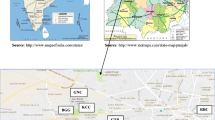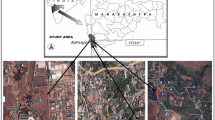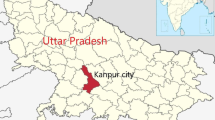Abstract
The aim of the present study is to biomonitor the tolerance level of roadside plant species towards mitigation of air pollution for the development of greenbelt. The leaves of four plant species (Azadirachta indica, Ficus benghalensis, Melia azedarach and Polyalthia longifolia) were collected from 41 sampling sites of Bathinda city during summer and winter seasons. Seasonal variation in APTI and API was determined in selected plants. Highest APTI (13.54) was reported in F. benghalensis during summer and lowest APTI (11.69) in A. indica during winter season. The APTI and API value revealed that F. benghalensis was the best performer, A. indica and M. azedarach were excellent performers and P. longifolia a good performer in greenbelt development to mitigate the air pollution. Pearson’s correlation analysis illustrated significant correlation between APTI, ascorbic acid, total chlorophyll, relative water and pH, respectively.

Similar content being viewed by others
References
Achakzai K, Khalid S, Adrees M et al (2017) Air pollution tolerance index of plants around brick kilns in Rawalpindi, Pakistan. J Environ Manage 190:252–258
Aji MM, Adamu AM, Borkoma MB (2015) Determination of air pollution tolerance index of selected trees in selected location in Maiduguri. Int J Sci Res Sci Technol 4:249–254
Akram A, Nudrat Shafiq et al (2017) Ascorbic acid-A potential oxidant scavenger and its role in plant development and abiotic stress tolerance. Front Plant Sci 8:613
Aleadelat W, Ksaibati K (2018) A comprehensive approach for quantifying environmental costs associated with unpaved roads dust. J Environ Econ Pol 7:130–144
Alotaibi MD, Alharbi BH, Al-Shamsi MA et al (2020) Assessing the response of five tree species to air pollution in Riyadh City, Saudi Arabia, for potential green belt application. Environ Sci Pollut Res Inter. https://doi.org/10.1007/s11356-020-09226-w
Arnon DI (1949) Copper enzymes in isolated chloroplasts Polyphenoloxidase in Beta vulgaris. Plant Physiol 24:1–15
Bahadoran M, Mortazavi SN, Hajizadeh Y (2019) Evaluation of Anticipated Performance Index, biochemical, and physiological parameters of Cupressus arizonica Greene and Juniperus excelsa Bieb for greenbelt development and biomonitoring of air pollution. Int J Phytoremed 21:496–502
Bakiyaraj R, Ayyappan D (2014) Air pollution tolerance index of some terrestrial plants around an industrial area. Int J Mod Res Rev 2:1–7
Banerjee S, Banerjee A, Palit D et al (2019) Assessment of vegetation under air pollution stress in urban industrial area for greenbelt development. Int J Environ Sci Te 16:5857–5870
Bharti SK, Trivedi A, Kumar N (2018) Air pollution tolerance index of plants growing near an industrial site. Urban Clim 24:820–829
Bora M, Joshi N (2014) A study on variation in biochemical aspects of different tree species with tolerance and performance index. The Bioscan 9:59–63
Cavanagh JAE, Zawar-Reza P, Wilson JG (2009) Spatial attenuation of ambient particulate matter air pollution within an urbanised native forest patch. Urban For Urban Gree 8:21–30
Chandawat DK, Verma PU, Solanki HA (2011) Air pollution tolerance index (APTI) of tree species at cross road of Ahmedabad city. Life Sci Leaflets 20:935–943
Das S, Prasad P (2010) Seasonal variation in air pollution tolerance indices and selection of plant species for industrial areas of Rourkela. Indian J Environ Prot 30:978–988
Dash SK, Dash AK (2018) Air pollution tolerance index to assess the pollution tolerance level of plant species in industrial areas. Asian J Chem 30:219–222
Dhankhar R, Mor V, Narwal S (2015) Anticipated performance index of selected plant species in university campus area, Rohtak, Haryana, Inida. Int J Adv Multidiscip Res 2:32–41
Duggal V, Rani A, Mehra R (2018) Risk assessment of 238U and 232Th in groundwater in Bathinda district of Punjab state, India. Int. J Adv Res Sci Engin 7:117–128
Geeta C, Namrata C (2014) Effect of air pollution on the photosynthetic pigments of selected plant species along roadsides in Jamshedpur, Jharkhand. Res Plant Biol 4:65–68
Govindaraju M, Ganeshkumar RS, Muthukumaran VR et al (2012) Identification and evaluation of air-pollution-tolerant plants around lignite-based thermal power station for greenbelt development. Environ Sci Pollut Res 19:1210–1223
Hariram M, Sahu R, Elumalai SP (2018) Impact assessment of atmospheric dust on foliage pigments and pollution resistances of plants grown nearby coal based thermal power plants. Arch Environ Contam Toxicol 74:56–70
Jain S, Bhattacharya T, Chakraborty S (2019) Comparison of plant tolerance towards air pollution of rural, urban and mine sites of Jharkhand: a biochemical approach to identify air pollutant sink. In Adv Waste Manage :123-142. Springer, Singapore.
Janhall S (2015) Review on urban vegetation and particle air pollution deposition and dispersion. Atmos Environ 105:130–137
Karmakar D, Padhy PK (2019) Air pollution tolerance, anticipated performance, and metal accumulation indices of plant species for greenbelt development in urban industrial area. Chemosphere 237:124–522
Kaur M, Nagpal AK (2017) Evaluation of air pollution tolerance index and anticipated performance index of plants and their application in development of green space along the urban areas. Environ Sci Pollut Res 24:18881–18895
Kaur R, Nayyar H (2014) Ascorbic acid: a potent defender against environmental stresses. Academic Press.
Kulkarni SD, Ingawale A (2014) Biomonitoring of air pollution in by correlating the pollution tolerance of some commonly grown trees in Waluj industrial area near Aurangabad, India. Int J Res Environ Sci Technol 4:102–106
Kwak MJ, Lee JK, Park S et al (2020) Evaluation of the importance of some East Asian tree species for refinement of air quality by estimating air pollution tolerance index, anticipated Performance index, and air pollutant uptake. Sustainability 12:3067
Liu Y, Ding H (2008) Variation in air pollution tolerance index of plants near a steel factory: implications for landscape-plant species selection for industrial areas. Trans Environ Dev 4:24–32
Madan S, Chauhan S (2015) Air pollution tolerance index and anticipated performance index of selected plant species in Haridwar City, India. Rep Opin 7:32–37
Nadgorska-Socha A, Kandziora-Ciupa M, Trzęsicki M et al (2017) Air pollution tolerance index and heavy metal bioaccumulation in selected plant species from urban biotopes. Chemosphere 183:471–482
Nayak A, Madan S, Matta G (2018) Evaluation of Air pollution tolerance index (APTI) and anticipated performance index (API) of some plants species in Haridwar City. Int J Environ Rehab Conserv 9:1–7
Ninave SY, Chaudhari PR, Gajghate DG et al (2001) Foliar biochemical features of plants as indicators of air pollution. Bull Environ Contam Toxicol 67:133–140
Ogunkunle CO, Suleiman LB, Oyedeji S et al (2015) Assessing the air pollution tolerance index and anticipated performance index of some tree species for biomonitoring environmental health. Agrofor Sys 89:447–454
Pandey AK, Pandey M, Tripathi BD (2016) Assessment of Air Pollution Tolerance Index of some plants to develop vertical gardens near street canyons of a polluted tropical city. Ecotoxicol Environ Saf 134:358–364
Patel D, Kumar JN (2018) An evaluation of air pollution tolerance index and anticipated performance index of some tree species considered for green belt development: a case study of Nandesari industrial area, Vadodara, Gujarat, India. Open J Air Pollut 7:1–13
Pathak V, Tripathi BD, Mishra VK (2011) Evaluation of anticipated performance index of some tree species for green belt development to mitigate traffic generated noise. Urban Urban Green 10:61–66
Prajapati SK, Tripathi BD (2008) Anticipated Performance Index of some tree species considered for green belt development in and around an urban area: a case study of Varanasi city, India. J Environ Manage 88:1343–1349
Rahmawati N, Basyuni M (2014) Chlorophyll content of soybean as affected by foliar application of ascorbic acid and inoculation of arbuscular mycorrhizal fungi in saline soil. Inter J Sci Technologi Res 3:127–131
Rai PK (2016) Impacts of particulate matter pollution on plants: Implications for environmental biomonitoring. Ecotoxicol Environ Saf 129:120–136
Rai PK (2019) Particulate matter tolerance of plants (APTI and API) in a biodiversity hotspot located in a tropical region: implications for eco-control. Particul Sci Technol:1–10.
Rai PK, Panda LL (2014) Dust capturing potential and air pollution tolerance index (APTI) of some road side tree vegetation in Aizawl, Mizoram, India: an Indo-Burma hot spot region. Air Qual Atmos Health 7:93–101
Rani D, Kohli RK (1991) Fresh matter is not an appropriate relation unit for chlorophyll content: experience from experiments on effects of herbicide and allelopathic substance. Photosynthetica 25:655–658
Reiss C (1993) Measuring the amount of ascorbic acid in cabbage Tested studies laboratory teaching. 7:85–96
Roy A, Bhattacharya T, Kumari M (2020) Air pollution tolerance, metal accumulation and dust capturing capacity of common tropical trees in commercial and industrial sites. Sci Total Environ. https://doi.org/10.1016/j.scitotenv.2020.137622
Seyyedinejad SM, Koochak H (2011) A study on air pollution Induced biochemical alterations in Eucalyptus camaldulensis. Aust J Basic Appl Sci 5:601–6
Shannigrahi AS, Fukushima T, Sharma RC (2004) Anticipated air pollution tolerance of some plant species considered for green belt development in and around an industrial/urban area in India: an overview. Inter J Environ Studies 61:125–137
Sharma B, Bhardwaj SK, Sharma S et al (2019) Pollution tolerance assessment of temperate woody vegetation growing along the National Highway-5 in Himachal Pradesh, India. Environ Monit Assess 191:177–185
Singh SK, Rao DN (1983) Evaluation of plants for their tolerance to air pollution. Proceed Sympos Air Pollut Control 1:218–224
Singh SN, Verma A (2007) Phytoremediation of air pollutants: a review. Environmental Bioremediation Technologies Springer, Berlin, Heidelberg:293-314.
Subramani S, Devaanandan S (2015) Application of air pollution tolerance index in assessing the air quality. Inter J Pharm Pharmaceu Sci 7:216–221
Vailshery LS, Jaganmohan M, Nagendra H (2013) Effect of street trees on microclimate and air pollution in a tropical city. Urban Urban Gree 12:408–415
Zhou C, Li S, Shaojian W (2018) Examining the impacts of urban form on air pollution in developing countries: a case study of China’s Megacities. Inter J Environ Res Public Health 15:1565
Acknowledgements
The authors would like to thank Central Instrumentation Laboratory (CIL) of Central University of Punjab for its support and facilities during research work.
Author information
Authors and Affiliations
Corresponding author
Ethics declarations
Conflict of interest
The authors declare no conflict of interest.
Additional information
Publisher's Note
Springer Nature remains neutral with regard to jurisdictional claims in published maps and institutional affiliations.
Rights and permissions
About this article
Cite this article
Yadav, R., Pandey, P. Assessment of Air Pollution Tolerance Index (APTI) and Anticipated Performance Index (API) of Roadside Plants for the Development of Greenbelt in Urban Area of Bathinda City, Punjab, India. Bull Environ Contam Toxicol 105, 906–914 (2020). https://doi.org/10.1007/s00128-020-03027-0
Received:
Accepted:
Published:
Issue Date:
DOI: https://doi.org/10.1007/s00128-020-03027-0




